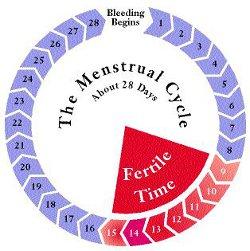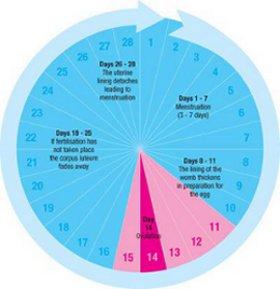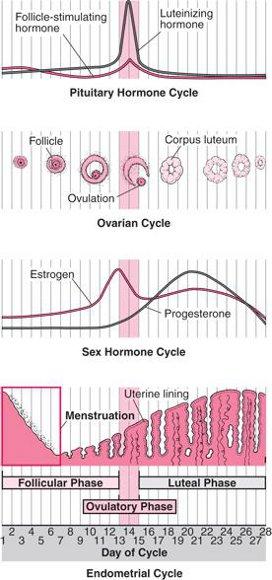Menstruation
Menstruation
Reproductive health refers to mortality, morbidity and quality of life attributable to the reproductive system, process and events experienced by men and women at all ages. The World Health Organisation (WHO, 1998) defines reproductive health as "a state of physical, mental and social well-being in all matters relating to the reproductive system at all stages of life." The term reproductive age group refers to the active reproductive years in women starting with menarche around 12-14 years and ending with menopause around 45-49 years. For demographic purposes, reproductive age group is usually defined as 15-49 years or 12-49 years.
Indicators of Reproductive health
The World Health Organisation indicators for monitoring progress towards Health for All (WHO, 1981) included a few broad indicators of reproductive health, such as Fertility rates, maternal mortality rate, ages at which mothers have children, and birth intervals. In 1996, the working group on Reproductive Health of the Administrative Committee on Coordination (ACC) task force on Basic social services for all (BSSA) recommended the following indicators.
- Total fertility rate (TFR)
- Maternal mortality ratio (MMR)
- Perinatal mortality rate
- Low birth weight prevalence
- Syphilis prevalence in pregnancy
- Anemia prevalence in pregnancy
- Infertility prevalence in women
- Prevalence of female genital mutilation
- HIV prevalence in pregnant women aged 15-24
Menstruation
Menstruation is the shedding of the lining of the uterus (endometrium) accompanied by bleeding. It occurs in approximately monthly cycles throughout a woman's reproductive life, except during pregnancy. Menstruation starts during puberty (at menarche) and stops permanently at menopause.
Menstrual cycle

The menstrual cycle begins with the first day of bleeding, which is counted as day 1. The cycle ends just before the next menstrual period. Menstrual cycles normally range from about 25 to 36 days. Only 10 to 15% of women have cycles that are exactly 28 days. Usually, the cycles vary the most and the intervals between periods are longest in the years immediately after puberty and before menopause.

Menstrual bleeding lasts 3 to 7 days, averaging 5 days. Blood loss during a cycle usually ranges from ½ to 2½ ounces. A sanitary pad or tampon, depending on the type, can hold up to an ounce of blood. Menstrual blood, unlike blood resulting from an injury, usually does not clot unless the bleeding is very heavy.
The menstrual cycle is regulated by hormones. Luteinizing hormone and follicle-stimulating hormone, which are produced by the pituitary gland, promote ovulation and stimulate the ovaries to produce estrogen and progesterone. Estrogen and progesterone stimulate the uterus and breasts to prepare for possible fertilization.
Source: World Health Organisation
Phases in menstruation cycle
The cycle has three phases

Follicular Phase
This phase begins on the first day of menstrual bleeding (day 1). But the main event in this phase is the development of follicles in the ovaries.
At the beginning of the follicular phase, the lining of the uterus (endometrium) is thick with fluids and nutrients designed to nourish an embryo. If no egg has been fertilized, estrogen and progesterone levels are low. As a result, the top layers of the endometrium are shed, and menstrual bleeding occurs. About this time, the pituitary gland slightly increases its production of follicle-stimulating hormone. This hormone then stimulates the growth of 3 to 30 follicles. Each follicle contains an egg. Later in the phase, as the level of this hormone decreases, only one of these follicles (called the dominant follicle) continues to grow. It soon begins to produce estrogen, and the other stimulated follicles begin to break down.
On average, the follicular phase lasts about 13 or 14 days. Of the three phases, this phase varies the most in length. It tends to become shorter near menopause. This phase ends when the level of luteinizing hormone increases dramatically (surges). The surge results in release of the egg (ovulation).
Ovulatory Phase
This phase begins when the level of luteinizing hormone surges. Luteinizing hormone stimulates the dominant follicle to bulge from the surface of the ovary and finally rupture, releasing the egg. The level of follicle-stimulating hormone increases to a lesser degree. The function of the increase in follicle-stimulating hormone is not understood
The ovulatory phase usually lasts 16 to 32 hours. It ends when the egg is released.
About 12 to 24 hours after the egg is released, the surge in luteinizing hormone can be detected by measuring the level of this hormone in urine. This measurement can be used to determine when women are fertile. The egg can be fertilized for only up to about 12 hours after its release. Fertilization is more likely when sperm are present in the reproductive tract before the egg is released.
Around the time of ovulation, some women feel a dull pain on one side of the lower abdomen. This pain is known as (literally, middle pain). The pain may last for a few minutes to a few hours. The pain is felt on the same side as the ovary that released the egg, but the precise cause of the pain is unknown. The pain may precede or follow the rupture of the follicle and may not occur in all cycles. Egg release does not alternate between the two ovaries and appears to be random. If one ovary is removed, the remaining ovary releases an egg every month.
Luteal Phase
This phase begins after ovulation. It lasts about 14 days (unless fertilization occurs) and ends just before a menstrual period. In this phase, the ruptured follicle closes after releasing the egg and forms a structure called a corpus luteum, which produces increasing quantities of progesterone. The corpus luteum prepares the uterus in case fertilization occurs. The progesterone produced by the corpus luteum causes the endometrium to thicken, filling with fluids and nutrients to nourish a potential fetus.
Progesterone causes the mucus in the cervix to thicken, so that sperm or bacteria are less likely to enter the uterus. Progesterone also causes body temperature to increase slightly during the luteal phase and remain elevated until a menstrual period begins. This increase in temperature can be used to estimate whether ovulation has occurred. During most of the luteal phase, the estrogen level is high. Estrogen also stimulates the endometrium to thicken.
The increase in estrogen and progesterone levels causes milk ducts in the breasts to widen (dilate). As a result, the breasts may swell and become tender.
If the egg is not fertilized, the corpus luteum degenerates after 14 days, and a new menstrual cycle begins. If the egg is fertilized, the cells around the developing embryo begin to produce a hormone called human chorionic gonadotropin. This hormone maintains the corpus luteum, which continues to produce progesterone, until the growing fetus can produce its own hormones. Pregnancy tests are based on detecting an increase in the human chorionic gonadotropin level.
National Toll Free Helpline (1800-11-6555) on Reproductive Health
The Jansankhya Sthirata Kosh (JSK) (National Population Stabilisation Fund) has been registered as an autonomous Society of Ministry of Health and Family Welfare, Government of India. JSK has to promote and undertake activities aimed at achieving population stabilisation at a level consistent with the needs of sustainable economic growth, social development and environment protection. Jansankhya Sthirata Kosh has initiated a first of its kind Toll Free-National Helpline (1800-11-6555) in India on Reproductive, Sexual Health, Family Planning and Infant and Child Health etc. Users may call the National Helpline (1800-11-6555) for getting easy access and availability of reliable information on reproductive, sexual health, contraception, pregnancy, infant and child health and related issues.
Related Resources
Last Modified : 2/21/2020
This topic provides information about Zero tillage...
This topic provides information related to steps t...
This topic covers information related to Acute res...
This topic provides about *99# Service- Innovative...
